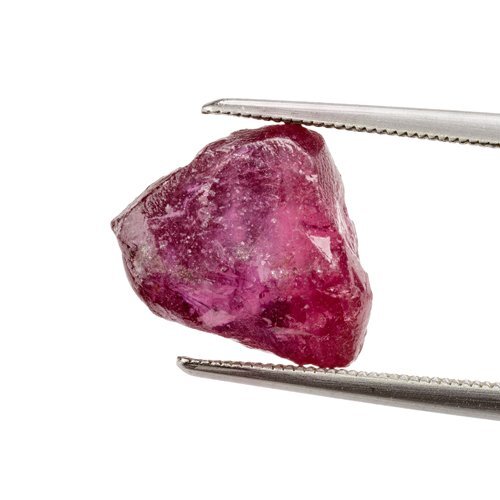Ruby, Ruby, Ruby, Ruby!!
If you had to choose, which stone would be your favourite?
I love the ruby. I have always admired its symbols of strength, paired with its feminine hues. Rubies are a fiery staple of the gemstone world. For centuries, rubies have been at the forefront of luxury. What sets this stone apart from less prized gemstones is the ruby's inherent beauty. But there's more to rubies than just this. Here are some interesting ruby facts that will uncover some of the perplexities behind July's birthstone.
A rough ruby, before it is cut and polished.
The history of rubies is a story rich in splendour and mystery. These precious gems have been mentioned in the Bible, worn by royalty throughout human history, and believed to protect ancient warriors in battle. They have been thought to act as a talisman for peace and a promise of wisdom and health for the holder. They are associated with love, passion, and power. But for all that, their very existence is still considered to be something of a geological miracle.
Experts and professors around the globe are yet to settle on a precise explanation for how rubies are formed. It’s known that a ruby is, in essence, a type of corundum (a certain family of stones) which is itself colourless when pure, and turns ruby red when chromium is introduced. Paired closely to rubies are sapphires. They are also a type of corundum, created when titanium and iron are part of the mix, turning the stones beautiful shades of blue. But the conditions needed to create rubies are so rare that a definitive explanation for their creation remains elusive.
One thing is for certain; rubies are one of the most precious gemstones in existence, commanding the greatest price per carat of any other gem, even diamonds!
The Carmen Lúcia Ruby
Some of the most famous rubies in history can today be found in the collections of world-class museums such as the Louvre, which houses the Anne of Brittany Ruby, and the Smithsonian, which is home to the Carmen Lúcia Ruby.
Photo by Chip Clark.
Gifted to the museum by Dr. Peter Buck in 2004 in memory of Carmen L. Buck.
At 23.10 carats, the Carmen Lúcia Ruby is the largest faceted ruby in the National Gem Collection and one of the finest large, faceted Burmese rubies known. The stone was mined in Burma in the 1930’s and possesses a combination of outstanding characteristics. Aside from its large size, this extraordinary gemstone displays a richly saturated red colour, combined with an exceptional degree of transparency.
Rubies can be found in Thailand, Madagascar and Mozambique, with African rubies being more pink in hue and Thai rubies leaning toward darker shades. The most significant source of fine rubies has been Burma, and in fact the term “Burmese Ruby” is related with the best and most valuable rubies. Burmese rubies are considered to be the finest colour – red to slightly purplish-red and medium-dark in tone. This colour is commonly referred to as “pigeon’s blood”!
For rubies, it is their colour, rather than their clarity, which makes them so valuable, and this is greatly determined by where the rubies are found. Ranging from vibrant orangey red to tones that are almost purple in hue, rubies can be many different shades.
While sapphire, emerald, and diamond gems weighing hundreds of carats exist, high-quality Burmese rubies larger than 20 carats are exceedingly rare. The Carmen Lúcia Ruby is mounted in a platinum ring with 2 triangular-cut diamonds totaling 2.38 carats. This magnificent ruby was a gift to the Smithsonian Museum and the people of the United States in 2004 from Dr. Peter Buck, in memory of his wife, Carmen Lúcia Buck. Her love for the United States, devotion to children, and appreciation for fine jewellery inspired the gift of this ruby for the American People to enjoy.
Rubies are also prized pieces in other collections, such as the British Crown Jewels, having long been the stone of choice for British coronation rings; a tradition which dates back to the 13th century.
Gold and ruby necklace
Did you know?
According to ancient folklore, people of India believed rubies would help them be at peace with their enemies.
In 2011, an 8.24-carat ruby ring belonging to Elizabeth Taylor and made by Van Cleef & Arpels sold at auction for $4.2 million, with the price per carat amounting to approximately $500,000!!!
Until the beginning of the 19th century, red spinels were thought to be rubies. Famous stones including "Black Prince's Ruby" and "Timur Ruby" were considered to be rubies until it was discovered that they and many other red stones were, in fact, the less precious stone, red spinels.
The most expensive ruby ever sold was the "Hope Ruby" which weighs 32.08 carats and sold for $6.74 million!!
Ruby is one of the four precious gemstones. The others are emerald, sapphire, and diamond.
Ruby comes from the Latin "rubens" meaning red.
Ruby measures 9 on the Mohs Scale of Hardness, second only to diamond and matched with sapphire. This makes ruby an extremely hard and durable gemstone.
Ancient civilisations even recognised their value; the Sanskrit word for ruby, “Ratnaraj”, translates to “King of Precious Stones”.
Illustration: The Spruce / Ran Zheng
References: Geogallery.si.eu, Thesprucecrafts.com, Boodles.com
Hello, World!





